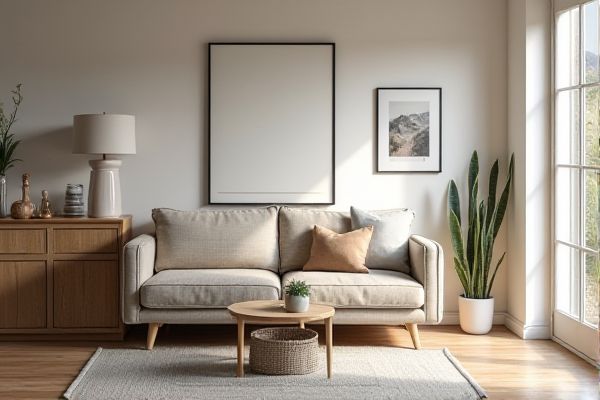
Shaker style emphasizes simplicity, functionality, and fine craftsmanship with clean lines and minimal ornamentation, while Scandinavian style focuses on light, airy spaces, natural materials, and a cozy, inviting atmosphere. Discover how these distinctive approaches can transform Your home by exploring the subtle differences in the rest of the article.
Table of Comparison
| Feature | Shaker Style | Scandinavian Style |
|---|---|---|
| Origin | 18th-century American, religious Shaker communities | 20th-century Nordic countries (Denmark, Sweden, Norway) |
| Design Philosophy | Simple, functional, utilitarian | Minimalist, light, functional with natural elements |
| Materials | Solid wood, mainly cherry, maple, pine | Light woods like birch, pine, ash; natural textiles |
| Color Palette | Natural wood tones, muted colors | Whites, light grays, pastels, natural hues |
| Furniture Characteristics | Clean lines, flat panels, exposed joinery | Simple shapes, smooth surfaces, organic forms |
| Decor Elements | Minimal, practical, hand-crafted | Cozy textiles, functional accessories, plants |
| Lighting | Functional, natural light emphasis | Bright, airy, use of natural and artificial light |
| Overall Mood | Calm, orderly, timeless | Bright, cozy, airy |
Introduction to Shaker and Scandinavian Styles
Shaker style emphasizes simplicity, functionality, and craftsmanship, with clean lines and minimal ornamentation reflecting its 18th-century American roots. Scandinavian style combines minimalism with cozy, light-filled interiors, featuring natural materials and a neutral color palette inspired by Nordic design principles. Both styles prioritize practicality and timeless elegance, making your home feel both inviting and uncluttered.
Historical Origins and Influences
Shaker style, rooted in the 18th-century American Shaker religious community, emphasizes simplicity, functionality, and craftsmanship influenced by their values of modesty and utility. Scandinavian style originates from the Nordic countries, blending minimalism with natural elements and light colors to create airy, functional spaces inspired by the harsh, cold climates. Your choice between these styles reflects a preference for the austere, handcrafted heritage of Shaker design or the modern, nature-connected warmth central to Scandinavian aesthetics.
Core Design Principles
Shaker style emphasizes simplicity, functionality, and craftsmanship with clean lines and minimal ornamentation, reflecting its roots in 18th-century American religious communities. Scandinavian style centers on minimalism, natural light, and organic materials, promoting a sense of coziness and warmth through functional design and muted color palettes. Both styles prioritize practicality and uncluttered spaces but differ in cultural inspiration and material emphasis.
Color Palettes and Material Choices
Shaker style interiors emphasize natural wood tones and muted earth colors such as warm browns, creams, and soft greys, highlighting craftsmanship with solid woods like cherry, maple, and pine. Scandinavian style embraces a lighter color palette dominated by whites, pale greys, and pastel hues, often combined with natural materials such as light oak, birch, and beech to create an airy and minimalist atmosphere. Both styles prioritize simplicity and function, but Shaker leans toward rustic warmth, while Scandinavian focuses on bright, understated elegance.
Furniture Design and Craftsmanship
Shaker style furniture emphasizes simplicity, functionality, and fine craftsmanship with clean lines, minimal ornamentation, and durable wood joinery techniques such as mortise and tenon. Scandinavian style furniture blends minimalism with organic forms, highlighting light woods like pine and beech, smooth surfaces, and ergonomic designs that enhance comfort and functionality. Both styles prioritize utility and quality craftsmanship but differ in aesthetic warmth, with Shaker favoring robust practicality and Scandinavian embracing airy, modern softness.
Functional vs. Aesthetic Approaches
Shaker style emphasizes functional design with simple, sturdy furniture prioritizing utility and minimal ornamentation, ensuring long-lasting practicality. Scandinavian style blends functionality with aesthetic appeal, featuring clean lines and natural materials that create bright, inviting spaces while maintaining usability. You benefit from Shaker's durability and Scandinavian's warmth when choosing a design that balances practicality and style.
Space Planning and Room Layouts
Shaker style emphasizes functional and efficient space planning with simple, symmetrical room layouts that enhance usability and create a sense of order. Scandinavian style prioritizes open, airy layouts that maximize natural light and encourage fluid movement, often incorporating multifunctional furniture to optimize small spaces. Both styles value minimalism but Shaker leans toward structured geometry while Scandinavian embraces organic flow and versatility in room design.
Decorative Elements and Accessories
Shaker style emphasizes simplicity and function, featuring minimal decorative elements like clean lines and modest wooden pegs, while Scandinavian style incorporates subtle natural motifs and light-toned textiles to add warmth and personality. Accessories in Shaker design are practical and sparse, such as handcrafted wooden bowls, whereas Scandinavian interiors often showcase cozy throws, ceramics, and greenery to enhance comfort. Choosing between these styles depends on whether Your preference leans toward utilitarian restraint or a soft, nature-inspired ambiance.
Popularity in Modern Interiors
Shaker style and Scandinavian style are both highly popular in modern interiors due to their emphasis on simplicity and functionality. Shaker style features clean lines, minimal ornamentation, and craftsmanship rooted in 18th-century American design, appealing to those seeking timeless, rustic charm. Scandinavian style emphasizes light, airy spaces with natural materials and muted color palettes, attracting contemporary homeowners looking for cozy, sustainable aesthetics.
Choosing Between Shaker and Scandinavian Styles
Choosing between Shaker and Scandinavian styles depends on your preference for simplicity with functionality or minimalism with warmth. Shaker style emphasizes clean lines, sturdy craftsmanship, and practical design, often featuring natural wood finishes and modest detailing. Scandinavian style highlights light, airy spaces, combining sleek, minimalist furniture with soft textures and neutral color palettes to create a cozy yet modern ambiance.
 homyna.com
homyna.com